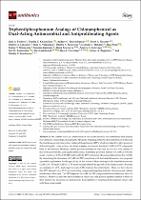| dc.contributor | Vall d'Hebron Barcelona Hospital Campus |
| dc.contributor.author | Pavlova, Julia A. |
| dc.contributor.author | Khairullina, Zimfira Z. |
| dc.contributor.author | Tereshchenkov, Andrey G. |
| dc.contributor.author | Nazarov, Pavel A. |
| dc.contributor.author | Lukianov, Dmitrii A. |
| dc.contributor.author | Volynkina, Inna A. |
| dc.contributor.author | Lyakhovich, Alex |
| dc.date.accessioned | 2022-01-14T11:09:25Z |
| dc.date.available | 2022-01-14T11:09:25Z |
| dc.date.issued | 2021-04-23 |
| dc.identifier.citation | Pavlova JA, Khairullina ZZ, Tereshchenkov AG, Nazarov PA, Lukianov DA, Volynkina IA, et al. Triphenilphosphonium Analogs of Chloramphenicol as Dual-Acting Antimicrobial and Antiproliferating Agents. Antibiotics. 2021 Apr 23;10(5):489. |
| dc.identifier.issn | 2079-6382 |
| dc.identifier.uri | https://hdl.handle.net/11351/6802 |
| dc.description | Antibiotic activity; Bacterial ribosome; Molecular dynamics simulations |
| dc.description.abstract | In the current work, in continuation of our recent research, we synthesized and studied new chimeric compounds, including the ribosome-targeting antibiotic chloramphenicol (CHL) and the membrane-penetrating cation triphenylphosphonium (TPP), which are linked by alkyl groups of different lengths. Using various biochemical assays, we showed that these CAM-Cn-TPP compounds bind to the bacterial ribosome, inhibit protein synthesis in vitro and in vivo in a way similar to that of the parent CHL, and significantly reduce membrane potential. Similar to CAM-C4-TPP, the mode of action of CAM-C10-TPP and CAM-C14-TPP in bacterial ribosomes differs from that of CHL. By simulating the dynamics of CAM-Cn-TPP complexes with bacterial ribosomes, we proposed a possible explanation for the specificity of the action of these analogs in the translation process. CAM-C10-TPP and CAM-C14-TPP more strongly inhibit the growth of the Gram-positive bacteria, as compared to CHL, and suppress some CHL-resistant bacterial strains. Thus, we have shown that TPP derivatives of CHL are dual-acting compounds targeting both the ribosomes and cellular membranes of bacteria. The TPP fragment of CAM-Cn-TPP compounds has an inhibitory effect on bacteria. Moreover, since the mitochondria of eukaryotic cells possess qualities similar to those of their prokaryotic ancestors, we demonstrate the possibility of targeting chemoresistant cancer cells with these compounds. |
| dc.language.iso | eng |
| dc.publisher | MDPI |
| dc.relation.ispartofseries | Antibiotics;10(5) |
| dc.rights | Attribution 4.0 International |
| dc.rights.uri | http://creativecommons.org/licenses/by/4.0/ |
| dc.source | Scientia |
| dc.subject | Ribosomes |
| dc.subject | Medicaments - Efectes fisiològics |
| dc.subject | Medicaments antiinfecciosos - Ús terapèutic |
| dc.subject.mesh | Anti-Infective Agents |
| dc.subject.mesh | /therapeutic use |
| dc.subject.mesh | Bacteria |
| dc.subject.mesh | /drug effects |
| dc.title | Triphenilphosphonium Analogs of Chloramphenicol as Dual-Acting Antimicrobial and Antiproliferating Agents |
| dc.type | info:eu-repo/semantics/article |
| dc.identifier.doi | 10.3390/antibiotics10050489 |
| dc.subject.decs | antiinfecciosos |
| dc.subject.decs | /uso terapéutico |
| dc.subject.decs | Bacteria |
| dc.subject.decs | /efectos de los fármacos |
| dc.relation.publishversion | https://doi.org/10.3390/antibiotics10050489 |
| dc.type.version | info:eu-repo/semantics/publishedVersion |
| dc.audience | Professionals |
| dc.contributor.organismes | Institut Català de la Salut |
| dc.contributor.authoraffiliation | [Pavlova JA, Khairullina ZZ] Department of Chemistry, Lomonosov Moscow State University, 119991 Moscow, Russia. [Tereshchenkov AG] A.N. Belozersky Institute of Physico-Chemical Biology, Lomonosov Moscow State University, 119992 Moscow, Russia. [Nazarov PA] A.N. Belozersky Institute of Physico-Chemical Biology, Lomonosov Moscow State University, 119992 Moscow, Russia. Laboratory of Molecular Genetics, Moscow Institute of Physics and Technology, 141700 Dolgoprudny, Russia. [Lukianov DA] Center of Life Sciences, Skolkovo Institute of Science and Technology, 143028 Skolkovo, Russia. [Volynkina IA] School of Bioengineering and Bioinformatics, Lomonosov Moscow State University, 119992 Moscow, Russia. [Lyakhovich A] Institute of Molecular Biology and Biophysics, Federal Research Center of Fundamental and Translational Medicine, 630117 Novosibirsk, Russia. Vall d’Hebron Institut de Recerca (VHIR), Barcelona, Spain |
| dc.identifier.pmid | 33922611 |
| dc.identifier.wos | 000653347400001 |
| dc.relation.projectid | info:eu-repo/grantAgreement/ES/PE2013-2016/PI17%2F02087 |
| dc.rights.accessrights | info:eu-repo/semantics/openAccess |


